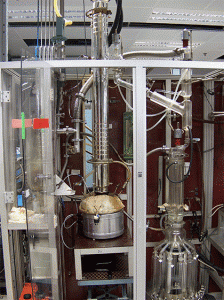The three distillation methods introduced to us in this lesson include True Boiling Point Distillation (TBP), ASTM Distillation, and Equilibrium Flash Vaporization (EFV). These methods are commonly used to generate laboratory data on crude oil, and their distillation fractions have varying degrees of separation. The largest degree of separation can be obtained by TBP distillation – this method utilizes a high reflux ratio (100:1) and a high number of theoretical plates (>100) for liquid vapor contact. The temperature remains constant during evaporation of each component, providing the least overlap between distillation fractions. ASTM distillation provides the second best degree of separation – in contrast to TBP distillation, the ASTM method operates without plates, has a reflux ratio of essentially zero, and the temperature does not remain constant during this process. EFV is the final method of distillation and utilizes a flowing feed (rather than a batch feed), where separation of liquid and vapor occurs in a flash drum. Distillation occurs at various heater outlet temperatures, providing the least amount of separation between fractions of the three methods. TBP distillation is essentially used for crude assay; the ASTM method is used for determining properties of refinery products; and EFV conveniently provides data for flashing operations.

